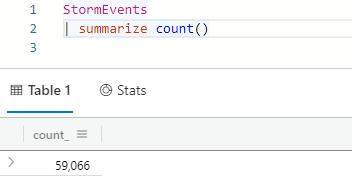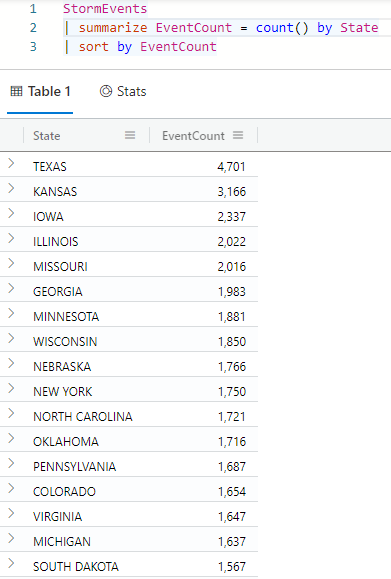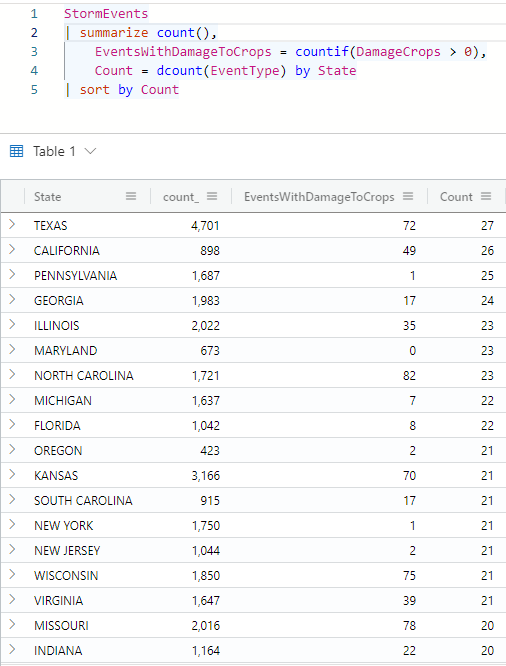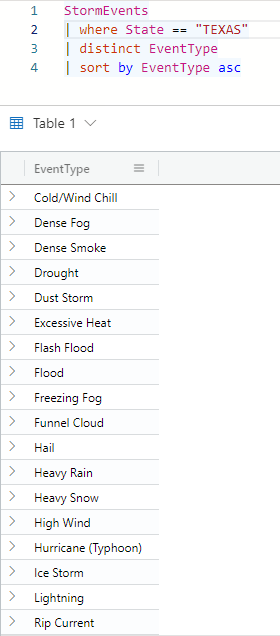Exercise - Count events using the count function
You can use a Kusto query to explore datasets and gain insights. Recall that we have a meteorological dataset and want to compare events to gain insights from this data. Here, you'll find out how many of a certain type of event occurred in a particular area.
Use the count function
The sample database we're using has an entry for each storm event in the US in 2007, for a total of about 60 thousand records.
To group these events into chunks of information, you'll use the summarize operator. summarize is used for all functions that aggregate groups of values of multiple rows to form a single summary value. You can summarize the whole table, for example, by counting the number of results using the following query:

You can also summarize data into groups of similar types of events by specifying the way you want to group the aggregation. For example, to count events by state, you can write a query to summarize count by state. In fact, the previous sentence is very similar to the actual query. You'll use the aggregation function called count(), which counts the number of rows by group. This function generates a new column that gives the count of events grouped by state, which we've renamed within the query from the default name count_ to EventCount. Renaming new columns is a recommended practice to make queries and their results more readable.
Copy and paste the query into your query editor.
StormEvents | summarize EventCount = count() by State | sort by EventCountRun the query by either selecting the Run button above the query window or by pressing Shift+Enter.
You should get results that look like the following image:

Use the dcount() and countif() functions
The previous query returned the number of events per state. There are, however, more sophisticated ways to count events.
- For example, you could count only certain types of events. The
countif()function counts records for which a predicate is true. The query usingcountif(DamageCrops > 0)would count the number of records for which the damage to crops was greater than zero. - You can also count distinct types of events by using the
dcount()function.
We've constructed a query that uses the summarize operator with these count functions to answer the following questions:
- How many storm events happened in each state?
- How many events in each state caused damage?
- How many different type of events happened in each state?
Notice that all elements within the summarize operator are separated by commas and are grouped by the same column, in this case State. Columns not named in the summarize operator are dropped. If you want to include other columns, name them after the column on which data is summarized.
Run the following query:
StormEvents | summarize count(), EventsWithDamageToCrops = countif(DamageCrops > 0), Count = dcount(EventType) by State | sort by CountYou should get results that look like the following image:

Notice the column names in the results. Which part of the query corresponds to each column? You can see that the
dcount()function created a new column and gave it the name Count. You'll also notice that you used this name as the column for thesortoperator in the query. How many different types of storms occurred in Texas?
Use the distinct operator
The previous query returned a distinct count of 27 different types of storms in Texas during the time period covered by this data. It would be interesting to further drill down and see the names of all those types of storms. To see a list of each different type of event in Texas, use the distinct() operator, which lists the distinct values of a particular column.
Run the following query:
StormEvents | where State == "TEXAS" | distinct EventType | sort by EventType ascYou should get results that look like the following image:

Take a look at the resulting list. Did any of the storm types surprise you?